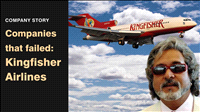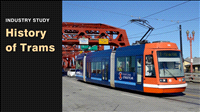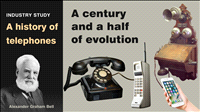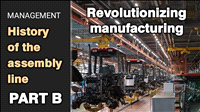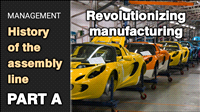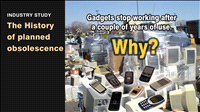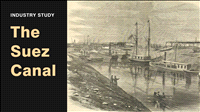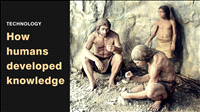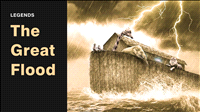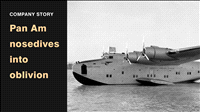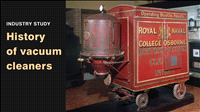History of typewriters | Industry study
By Kiron Kasbekar | 20 Feb 2023
I am Kiron Kasbekar, and the video I’ve brought here for you today is a brief discussion on the subject of the history of the typewriter.
Now some of you might exclaim, ‘Typewriters! What’s that?’
Others might say, ‘Oh, yes! What happened to them? Haven’t seen them in ages! Even forgotten how they look like, or how they work!’
Well, long before people started using computers, they used typewriters to produce documents. Typewriters were machines on which people typed directly on paper before computers and printers became popular since the 1980s.
But before I start on that, one request.
I hope you’ve seen our earlier videos and liked them. Please subscribe to this channel, if you have not done so already. Do also click on the ‘like’ button below. And do share this link with your friends.
I also hope you will watch the entire length of this video. Now let me get back to it.
When you walk into a business office today, what is that one thing strikes your attention?
It is the computer!
Mostly desktop computers with biggish screens, and some laptop computers with smaller screens, which are more compact. You also hear a bit of noise from fingers hitting keyboards – especially when they hit the spacebar. But, otherwise, the sounds that emanate from the office are mostly people talking, on their landline or mobile phones, or with colleagues in the room. Or just the hum of the air-conditioning.
Now let’s go back a few decades. If you’d walked into a business office half a century ago, you would also have seen people sitting at their desks. But they would have been reading sheets of paper or bulky, printed reports. Or they’d have been writing with pen or pencil on paper.
Writing with a pencil was often useful because if you made a mistake, you could easily erase the error and write the correct thing instead. So when was the last time you used an eraser? Five years ago? Ten? And if you do still own an eraser, has it got lost somewhere in a drawer in your desk?
But in the days before computers, erasers were commonly used. You’d have found it on your desk anytime you wanted it.
Talking of the days before computers, let’s go take a look at one of those days in a typical office.
Some people in the office would have had typewriters in front of them, and they would be typing away furiously. You would have heard the loud clacking sound of typewriter keys, and the whirring, whacking and ringing sounds of the carriage return.
Unlike today’s offices, where nearly everyone has a computer on their desk, offices in the middle of the 20th century had only a few typewriters. Most people would have piles of paper sheets and cardboard files stacked on their tables, and you would also find stacks of files on the floor next to some of the tables as the shelves behind them overflowed with files.
Only some people in the office could be seen with typewriters on their desks. You could see them staring at sheets of manuscripts or notes on one side, or placed behind the typewriter rollers, and typing away non-stop on their machines.
Some of them didn’t even have to look at the keyboards. So expert had they become that their fingers automatically moved to the typewriter keys they needed to hit – so they could keep their eyes focussed on reading the content of the paper sheets on the side or on a stand behind the typewriter as they typed away.
Others, less expert, would be moving their eyes back and forth between the manuscripts and the keyboard because they had to look for the right keys to hit after every few words they read from the manuscript. They would often be junior executives who didn’t have typists or secretaries assigned to them.
Most managers, however, would not have typewriters on their desks. They would write stuff on sheets of paper and pass the sheets on to their secretaries or to someone in a typists’ pool. And then they would wait for the typed sheets to come back from the secretaries or typists. That often gave them an excuse to go to the coffee machine or walk across the room for a chat with a colleague who too was waiting for a typist to deliver some sheets.
That was not the end. Once the typing was done, the managers would check the typed copy once or twice. If there were mistakes, they would mark them on the typed page and return to the typists for re-typing of the entire sheet. This was inevitable because more often than not either typists misread a badly scribbled manuscript or the writer decided to make changes after seeing the typed script.
You would often see a word – STET – which you rarely see nowadays. The word means ‘let it stand’ in Latin, and it was used when someone canceled or corrected some words, and then regretted it. So ‘stet’ meant that the cancelation or correction should be ignored. Journalists of those days were very familiar with the word.
By the way, newspaper offices were different. In these offices, nearly all the staff would have typewriters on their desks. Only very senior editors would have secretaries who would take dictation from them in shorthand and do their typing for them. But they themselves could also type, and often did so.
Now let us look at the product.
The typewriter had a list of inventors who created different machines to do more or less the same thing, but differently. As happened with some other products, the first typewriters to be invented, back in the 19th century, were big and cumbersome. As big as pianos, I’ve read, though I have not seen an image of such a large typewriter. What was worse, they were slow. Much slower than handwriting.
Then, one day in 1867, American inventor Christopher Latham Sholes read an article in the journal Scientific American about a new machine invented in Britain. One of the early typewriters. Sholes made up his mind to create his own version of the machine, which would be more practical to use.
He didn’t think his first attempt was good enough. The machine was too slow for his satisfaction. So he made further improvements, and on 23 June 1868, he patented his second model. That model had a speed that far exceeded the speed of a pen.
This machine too was rather crude, so Sholes took a few more years to improve on it. Then, in 1873, he persuaded gunsmiths E. Remington and Sons, based in Ilion, New York, to take up his latest design for manufacture.
The first of these typewriters began to be marketed in 1874, and soon they were renamed as Remington.
Mark Twain, author of several books, whose characters like Tom Sawyer and Huckleberry Finn became popular across the world, purchased one of these machines, and became the first author to prepare a typewritten manuscript for one of his books.
The age of mechanical typewriters lasted a long time, by modern standards. After more than a century and a half following their advent in offices, came the electric typewriters. Between the purely mechanical typewriters and today’s computers there was a brief period when some offices used electric typewriters.
When I say ‘brief’, I mean the period when electric typewriters were commonly used.
Curiously, electric typewriters of a kind have existed since 1870. That was the year when Thomas Edison laid the basic groundwork for these machines. He developed a typewriter that printed letters and numbers from inputs keyed in remotely. The inputs were made through a specially designed typewriter and the data was transmitted via telegraph lines to rolls of paper tape at the receiving end of the line. It was called the Universal Stock Ticker.
After that there were other inventions similar to typewriters. One invention that succeeded in the market was developed in 1914 by James Fields Smathers of Kansas City. It was the first practical electric typewriter.
In 1920, Smathers, who had earlier been in the army when he thought up the invention, produced a working model of an electric typewriter, and then, in 1923, he handed it over to Rochester-based Northeast Electric Company for commercialization.
Northeast Electric sold the technology to Remington Electric along with the motors, which Northeast made. But when, after Remington had made 2,500 typewriters, Northeast asked Remington to sign a firm contract for another batch, Remington refused to make a commitment because it was in negotiation with Rand Corporation to create their joint venture, Remington Rand.
Eventually Northeast decided to enter the typewriter business on its own, and launched its first Electromatic typewriter. One thing led to another, and, in 1928, Delco, a division of General Motors, acquired Northeast Electric and then spun off the typewriter business as Electromatic Typewriters, Inc. In 1933 that company was acquired by IBM, which then spent $1 million to redesign the machine and launch it as the IBM Electric Typewriter Model 01.
Electric typewriters were nothing but mechanical typewriters in which the typing strokes were powered by an electric motor drive. At the touch of the typist’s fingers on a key the typewriter would actuate the actions that would result in the proper key hitting the inked ribbon on the paper.
Because of their lighter touch, typists could type faster, yet suffer from less fatigue. And, of course, they were less noisy. The typing would be more uniform unlike with the pervious non-electric machines because the force of the key hitting the ribbon and paper was controlled by the electric motor, and so it did not vary. These machines could also produce more carbon copies.
Soon all major typewriter manufacturers began to offer electric typewriters. But, while their use grew rapidly in America and Europe, in countries like India, sales were slower because the electric machines were much more expensive than the older purely mechanical ones. Also, there was reluctance to throw away existing typewriters, and a tendency to keep using them until they broke down. Which was very infrequently. For they could be repaired.
A mid-level electric typewriter cost around US$365 in 1950 (or over US$4,070 at current prices, i.e., over Rs.333,000). A Godrej typewriter cost just Rs.630 in 1955, or about US$132 at the exchange rate of those days. Why would anyone pay 2.75 times for an electric typewriter simply because it made a little less noise, and the final output was visually a little better?
Compare those electric typewriters with a Lenovo machine available in India today – with a 19.5 inch screen, Intel Core i7, 4 GB memory, 1 TB hard disk, and free DOS – Rs.34,000!
The New York Times of 16 December 1974 commented that ‘the present healthy sales of electric models contrast with the static sales picture for manual and portable models. Prices range from around $300 for a standard manual machine to as high as $15,000 for a specialized electric model.’ But this was America.
So, even when the going was good, the numbers were pretty small.
According to a New York Times article dated 23 November 1984, IBM and Xerox were each selling between 115,000 and 200,000 electric typewriters; European companies were selling 250,000, or 38 per cent of the market, and Japanese companies about 200,000, or 26 per cent.
The result was that manual typewriters continued to be used until personal computers came on the scene.
The first computers were basically word processors, which could also do a few other things, including calculations, and many more businesses went for them. Typewriters were set aside.
Since those days in the 1980s, computers have become increasingly powerful, and cheaper with every passing year, especially in comparison with the power and features they offer.
Typewriters really got cast out after the advent of personal computers. Not only did these new machines – even the plain PCs, which did not have a hard disk – improve the speed of typing and the quality of the output, they also enabled users to check the copy and correct errors before printing the typed matter on paper.
We’ve moved a great distance since the launch of the PC. With the spread of computerization and of computer networks in offices and online, we are able to do things way, way faster than we could thirty or forty years ago.
Computer sales shot up to over 300 million a year a few years ago before declining a bit in the last couple of years. And they are expected to bounce back by 2024 or 2025. Those sales levels are way higher than the sales of typewriters even at their peak levels.
Well, today, if you ask a college student whether they know how to use a typewriter, you will probably get a blank stare. Someone may ask: ‘It doesn’t have a screen? How can I type without a screen?’ If you tell them that you can see the typed matter on the paper on the roller (or platen), they wouldn’t know how to visualize what you are saying. Paper on the roller? They have never even seen a typewriter. So how would they know how to use it?
Well, if you had not seen a typewriter before, you have at least seen photographs of some typewriters in this video. But do write your comments in the space below about what you think about typewriters.






